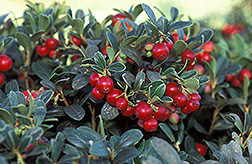This page has been archived and is being provided for reference purposes only. The page is no longer being updated, and therefore, links on the page may be invalid.
|
Read the magazine story to find out more. |
|
|
Fruits of the Future?
By David ElsteinJanuary 5, 2005
Have you ever tasted an elderberry or lingonberry? How about an aronia berry? These three lesser-known fruit crops are being studied by Agricultural Research Service (ARS) scientists who hope to make these fruits more popular with consumers.
At the ARS National Clonal Germplasm Repository in Corvallis, Ore., research leader Kim E. Hummer and her staff are studying what are called "minor crops"--fruits that may be popular in other countries--to see if they can successfully grow them here. Another example is the edible-fruited honeysuckle, which looks somewhat like a blueberry and has its own unique flavor, very different from the more popular ornamental honeysuckles with orange fruit.
There are more than 600 minor crops in the United States. While any crop that's grown on fewer than 300,000 acres nationally is considered a minor crop, many of the crops studied in Corvallis are grown on only a few hundred acres.
In some cases, such as with kiwifruit, the fruit may start off as a minor crop but eventually become a market staple. The scientists also are studying hardy kiwifruit, which is related to the fuzzy kiwifruit found in supermarket produce sections. The hardy kiwifruit has a smooth skin and is the size of a large grape, but has green flesh and black seeds similar to the traditional kiwi.
Two problems with the current hardy kiwifruit cultivars are that they are smaller than desired and only ripen during a three-week window, meaning they can only be sold for a few weeks a year. Geneticist Chad E. Finn at the ARS Horticultural Crops Research Laboratory, also in Corvallis, is trying to identify new cultivars from populations of wild hardy kiwifruit collected in China that have larger fruit and ripen at different times in the season than current cultivars.
Read more about the repository and the fruit research in the January issue of Agricultural Research magazine.
ARS is the U.S. Department of Agriculture's chief scientific research agency.

